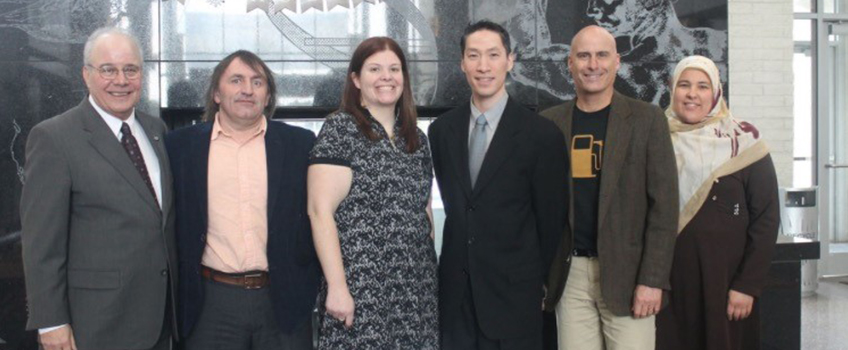Stockton Graduate Receives Patent-Pending Certificate for Method of Measuring Limb Volume in Lymphedema Patients

President Harvey Kesselman, Russell Manson, professor of Physics, Catherine Rosenberg, a Stockton alumna, Dr. Eric Chang, a surgeon at Fox Chase Cancer Center in Philadelphia, Ron Hutchinson, associate professor of Biology, and Suzanne Nezzar, associate professor of Mathematics. (Photo: Provided by Catherine Rosenberg)
For Immediate Release; Photos on Flickr
Contact: Susan Allen
News and Media Relations
Galloway, N.J. 08205
Susan.Allen@stockton.edu
(609) 652-4790
www.stockton.edu/media
Galloway, N.J. - Sitting in the doctor’s office, Catherine Rosenberg, of Little Egg Harbor Township, noticed something on a medical report that most patients wouldn’t—the mathematical formula used to calculate the volume of fluid in her swollen leg.
Rosenberg, who was diagnosed with synovial sarcoma at 8 years old, conquered cancer, but the radiation treatments led to her developing lymphedema, a condition that causes severe swelling in the limbs.
Immediately after seeing the formula, her knowledge of numerical analysis told her that there are much more accurate ways to calculate the volume of fluid buildup. Two Stockton degrees, an undergraduate degree in Mathematics and a master’s in Computational Science, and a dedication to advance the field of medicine led her to develop a patent-pending method of measuring fluid in lymphedema patients with help from a number of professors at Stockton and her doctor, Eric Chang.
Russell Manson, professor of Physics and her research project adviser, Suzanne Nezzar, associate professor of Mathematics, and Ron Hutchinson, associate professor of Biology, all supported her work.
During her recent lecture to students in Stockton’s Biology Seminar, she presented Manson with the patent-pending certificate. He commended Rosenberg and highlighted her enthusiasm for the research she is doing, noting that it is this passion that drives researchers forward.
In her presentation, Rosenberg presented the formula that she uses to calculate limb volumes, which filled an entire PowerPoint slide with numbers, variables and math operations. In simplified terms, a series of cross-sectional areas going up the limb are mathematically integrated over an interval to measure the volume of a limb.
At times, Rosenberg has had a 33 percent volume difference between her legs due to lymph fluid buildup. Lymph nodes damaged during cancer treatment result in a blockage of the lymphatic system, part of the immune system, preventing lymph fluid from draining.
For 25 years, Rosenberg managed lymphedema, wearing compression wraps on her leg and undergoing manual drainage. As time went on, the condition worsened, as did her hip, which suffered from extensive radiation, eventually leading her to have a hip replacement. Following hip surgery, a dislocation of the hip led her to Dr. Eric Chang, a surgeon at Fox Chase Cancer Center in Philadelphia, who could help her to reduce the swelling symptoms of lymphedema through vascularized lymph node transfer.
The surgery was successful, reducing swelling to a 9 percent difference, allowing her to do things she never imaged she would be able to do again.
Rosenberg is currently in a doctoral program at Rutgers University studying computational and integrative biology. The best medical care and doctors saved her life, and now, she is using her mathematical gifts to give back to the field.


